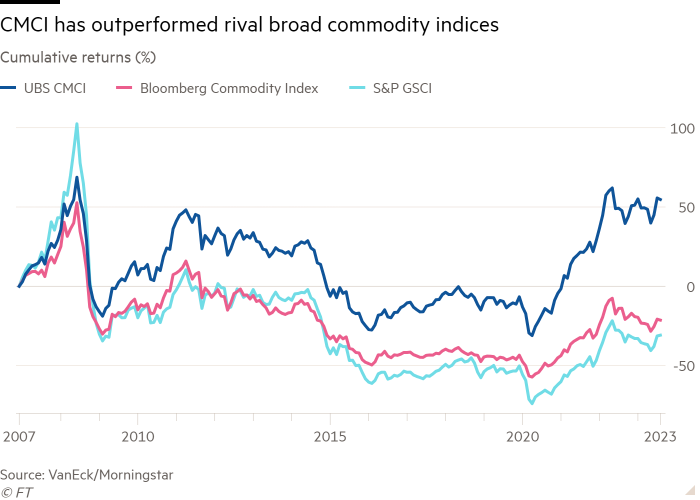VanEck commodities ETF highlights complexities of investing

Simply sign up to the Exchange traded funds myFT Digest -- delivered directly to your inbox.
Latest news on ETFs
Visit our ETF Hub to find out more and to explore our in-depth data and comparison tools
VanEck’s decision last month to launch an exchange traded fund version of its $570mn constant maturity commodities index mutual fund highlights some of the issues around using such ETFs.
Despite VanEck’s strong conviction in the strategy, it has taken the company 13 years since the launch of the mutual fund to unveil an ETF version.
“Following a difficult bear market in commodities that began in the middle of the last decade, we are excited to expand our offerings to those investors that prefer the features of exchange traded funds, such as intraday liquidity, at a time when more investors are considering the merits of commodities in their portfolio,” said Brandon Rakszawski, senior ETF product manager at VanEck.
Commodities are often seen as a hedge against inflation and while headline price pressures have declined from recent highs, they are still higher than central bank targets in most developed countries.
In addition, despite fears that a recession would damp demand for commodities, proponents of commodities ETFs argue that long-term demand will be underpinned by the global transition from a reliance on fossil fuels to alternative sources.
“There are 1.4bn ICE [internal combustion engine] autos on the planet and replacing them will take a lot of mining and minerals,” said Robert Minter, director of ETF investment strategy at abrdn. “The math is straightforward.”
But even if ETF investors are convinced by the inflation or long-term transition arguments, there are a number of factors to consider before deciding which commodities vehicle to choose.
There are pure-play oil and gas, industrial metals and gold ETFs, but these funds expose investors to a particular commodity without the diversification of broad-based exposures.
If investors opt for a broad-based approach there are further choices to make. Traditional commodities futures indices emphasise short-dated futures contracts, making them more vulnerable to negative roll yield. This occurs when the sale of a maturing contract at one price and the purchase of a longer-dated contract at a higher price causes a loss for the investor each time this trade is executed.

The newly launched VanEck CMCI Commodity Strategy ETF (CMCI) follows the CMCI index launched by UBS in 2007, which aims to reduce the impact of roll yield on investor returns.
It seeks to do so by adopting a series of investment maturities for each individual commodity. These are swapped for longer-dated contracts on a daily basis to maintain a constant maturity, potentially reducing the impact of roll yield.
Yet, even this carefully crafted approach will not always be the right choice, according to Virat Agarwal, head of commodities structuring at UBS Investment Bank.
“If your investment horizon is very short, say weeks to a few months, the effects of [positive] roll yield will probably have a low impact on overall returns. Hence a traditional index with investment in futures contracts close to the spot could provide a simple exposure,” said Agarwal.
“But for more strategic investors in commodities, CMCI offers a balanced exposure across the forward prices,” he added.
Latest news on ETFs

Visit the ETF Hub to find out more and to explore our in-depth data and comparison tools helping you to understand everything from performance to ESG ratings
Amin Rajan, chief executive of Create-Research, a consultancy, said that its latest institutional survey showed commodities were now a “notable element” in asset allocation, with 42 per cent of respondents saying commodities excluding gold would be suitable inflation protection for their pension portfolio, against 28 per cent for commodity-linked currency funds, 8 per cent for gold and 5 per cent for hedge funds.
“Institutional investors have entered an era of structurally high inflation,” said Rajan. He said commodity prices could drive headline inflation, but that investing in them provided ballast against market volatility, due to their low correlation with equities and bonds.
However, his analysis points to the even more granular choices investors face if they choose to seek commodities exposure in their portfolio.
“They are not the holy grail, if a deep recession hits demand,” he said.
Comments